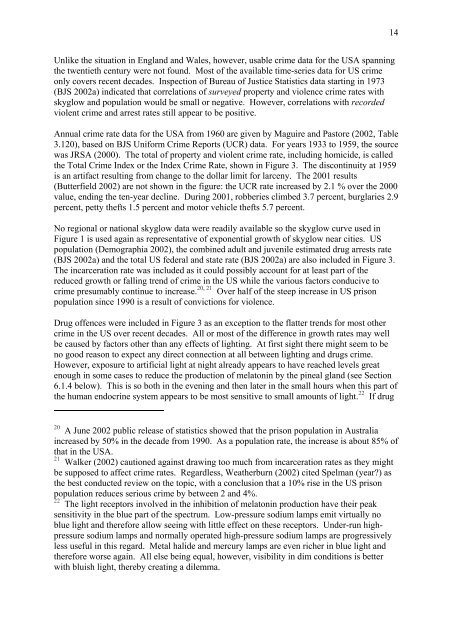Outdoor Lighting and Crime - Amper
Outdoor Lighting and Crime - Amper
Outdoor Lighting and Crime - Amper
You also want an ePaper? Increase the reach of your titles
YUMPU automatically turns print PDFs into web optimized ePapers that Google loves.
Unlike the situation in Engl<strong>and</strong> <strong>and</strong> Wales, however, usable crime data for the USA spanning<br />
the twentieth century were not found. Most of the available time-series data for US crime<br />
only covers recent decades. Inspection of Bureau of Justice Statistics data starting in 1973<br />
(BJS 2002a) indicated that correlations of surveyed property <strong>and</strong> violence crime rates with<br />
skyglow <strong>and</strong> population would be small or negative. However, correlations with recorded<br />
violent crime <strong>and</strong> arrest rates still appear to be positive.<br />
Annual crime rate data for the USA from 1960 are given by Maguire <strong>and</strong> Pastore (2002, Table<br />
3.120), based on BJS Uniform <strong>Crime</strong> Reports (UCR) data. For years 1933 to 1959, the source<br />
was JRSA (2000). The total of property <strong>and</strong> violent crime rate, including homicide, is called<br />
the Total <strong>Crime</strong> Index or the Index <strong>Crime</strong> Rate, shown in Figure 3. The discontinuity at 1959<br />
is an artifact resulting from change to the dollar limit for larceny. The 2001 results<br />
(Butterfield 2002) are not shown in the figure: the UCR rate increased by 2.1 % over the 2000<br />
value, ending the ten-year decline. During 2001, robberies climbed 3.7 percent, burglaries 2.9<br />
percent, petty thefts 1.5 percent <strong>and</strong> motor vehicle thefts 5.7 percent.<br />
No regional or national skyglow data were readily available so the skyglow curve used in<br />
Figure 1 is used again as representative of exponential growth of skyglow near cities. US<br />
population (Demographia 2002), the combined adult <strong>and</strong> juvenile estimated drug arrests rate<br />
(BJS 2002a) <strong>and</strong> the total US federal <strong>and</strong> state rate (BJS 2002a) are also included in Figure 3.<br />
The incarceration rate was included as it could possibly account for at least part of the<br />
reduced growth or falling trend of crime in the US while the various factors conducive to<br />
crime presumably continue to increase. 20, 21 Over half of the steep increase in US prison<br />
population since 1990 is a result of convictions for violence.<br />
Drug offences were included in Figure 3 as an exception to the flatter trends for most other<br />
crime in the US over recent decades. All or most of the difference in growth rates may well<br />
be caused by factors other than any effects of lighting. At first sight there might seem to be<br />
no good reason to expect any direct connection at all between lighting <strong>and</strong> drugs crime.<br />
However, exposure to artificial light at night already appears to have reached levels great<br />
enough in some cases to reduce the production of melatonin by the pineal gl<strong>and</strong> (see Section<br />
6.1.4 below). This is so both in the evening <strong>and</strong> then later in the small hours when this part of<br />
the human endocrine system appears to be most sensitive to small amounts of light. 22 If drug<br />
20 A June 2002 public release of statistics showed that the prison population in Australia<br />
increased by 50% in the decade from 1990. As a population rate, the increase is about 85% of<br />
that in the USA.<br />
21 Walker (2002) cautioned against drawing too much from incarceration rates as they might<br />
be supposed to affect crime rates. Regardless, Weatherburn (2002) cited Spelman (year?) as<br />
the best conducted review on the topic, with a conclusion that a 10% rise in the US prison<br />
population reduces serious crime by between 2 <strong>and</strong> 4%.<br />
22 The light receptors involved in the inhibition of melatonin production have their peak<br />
sensitivity in the blue part of the spectrum. Low-pressure sodium lamps emit virtually no<br />
blue light <strong>and</strong> therefore allow seeing with little effect on these receptors. Under-run highpressure<br />
sodium lamps <strong>and</strong> normally operated high-pressure sodium lamps are progressively<br />
less useful in this regard. Metal halide <strong>and</strong> mercury lamps are even richer in blue light <strong>and</strong><br />
therefore worse again. All else being equal, however, visibility in dim conditions is better<br />
with bluish light, thereby creating a dilemma.<br />
14
















